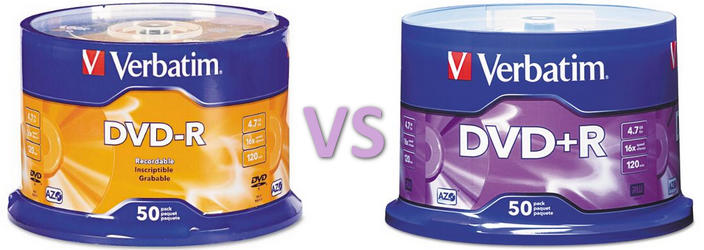DVD-R vs DVD+R: What's the Difference between DVD-R and DVD+R
There are several DVD formats that have been developed over the years. Among them, DVD-R and DVD+R are the most popular DVD formats used for recording data. If you want to record data onto a DVD disc, you need to know which format your DVD burner supports and which format is compatible with the device on which you plan to play the recorded content. If your DVD burner only supports DVD-R, you need to use DVD-R discs to record data, and if your DVD burner supports DVD+R, you need to use DVD+R discs.
While DVD-R and DVD+R share some similarities, there are also differences between them that can impact their compatibility with devices and their ability to store data. In this article, we will explore the differences between DVD-R and DVD+R, their advantages, and disadvantages to help you choose the right format for your needs.

Table of Contents
Part 1. What are DVD-R and DVD+R?
What does DVD-R mean?
DVD-R stands for DVD-Recordable. DVD-R is a write-once format that allows users to record data onto a DVD disc using a compatible DVD burner. Once data is recorded on a DVD-R disc, it cannot be erased or overwritten. DVD-R was developed by Pioneer in 1997 and is compatible with most DVD players and DVD-ROM drives.
What does DVD+R mean?
DVD+R stands for DVD+Recordable. DVD+R is a newer write-once format developed by a consortium of companies, including Philips, Sony, and HP, in 2002. Like DVD-R, data is recorded onto the disc using a laser, but DVD+R discs have a different structure and use a different error correction system. DVD+R discs also support a technology called "bitsetting," which allows them to be set to play in a wider range of DVD players.
Part 2. Difference between DVD-R and DVD+R
When it comes to comparing DVD-R and DVD+R, there are several factors to consider, including capacity, compatibility, bitsetting, error correction, longebity, and more. Let's delve into a detailed comparison of these two formats.
DVD-R VS DVD+R: Capacity
In terms of storage capacity, both DVD-R and DVD+R formats offer similar options for recording data. Both formats can store up to 4.7GB of data on a single-layer disc and up to 8.5GB on a dual-layer disc (DVD+R DL or DVD-R DL).
4.7GB capacity allows for approximately 120 minutes of video content in standard DVD quality.
DVD-R VS DVD+R: Compatibility
DVD-R vs DVD+R, which is more compatible? Both DVD-R and DVD+R discs are widely compatible with most DVD players and DVD-ROM drives.
However, DVD-R offers wider compatibility for playback compared to DVD+R, particularly with significantly older DVD players. DVD+R discs tend to have better compatibility with newer devices and are especially known for their enhanced compatibility with DVD players through bitsetting technology.
In practical terms, the compatibility differences between DVD-R and DVD+R are minimal for the majority of modern devices, and both formats should work effectively for most users.
To ensure compatibility, it's always a good idea to check the user manual or specifications of your specific DVD player or DVD-ROM drive to see if it has any specific recommendations or limitations regarding the supported disc formats.
DVD-R VS DVD+R: Bitsetting
DVD+R discs support bitsetting. This feature can change the book type to improve compatibility with a broader range of DVD players, increasing the likelihood of successful playback.
However, DVD-R discs do not support bitsetting.
DVD-R VS DVD+R: Error Correction
DVD-R uses a specific error correction system, which allows for effective recovery of data from scratched or damaged discs. However, the error correction capabilities may not be as robust as those of DVD+R.
DVD+R utilizes a different error correction system, which generally provides better error correction capabilities. This can enhance the chances of successful data recovery from mildly damaged or scratched discs.
DVD-R VS DVD+R: Usability
DVD-R discs are straightforward to use, as they are compatible with most devices, widely available, and can be burned using various DVD burners.
DVD+R discs are also user-friendly, and their bitsetting feature offers additional flexibility in terms of compatibility. They can be burned using compatible DVD burners.
DVD-R VS DVD+R: Availability and Price
DVD-R discs have been available for a longer time and are generally more widely produced. Consequently, they tend to be slightly more affordable than DVD+R discs.
DVD+R discs are also readily available and competitively priced. However, due to the presence of additional features like bitsetting, they may be slightly more expensive than DVD-R discs.
DVD-R VS DVD+R: Burning Speed
DVD-R and DVD+R formats can have differences in burning speed and burning quality, although these differences are not inherent to the formats themselves but rather depend on the specific DVD burner and media used.
DVD-R discs typically have wider support for faster burning speeds across various DVD burners. Burning speeds can range from 1x to 16x or higher, depending on the capabilities of the burner and the specific media.
DVD+R discs also support various burning speeds, including 1x to 16x or higher. However, some older DVD burners may have limited speed support for DVD+R discs.
DVD-R VS DVD+R: Burning Quality
DVD-R discs have been available for a longer time and have gone through extensive development and refinement. As a result, they often have better overall compatibility and burning quality across a wide range of DVD burners.
DVD+R discs have also improved their burning quality over the years and are now on par with DVD-R in terms of reliability and burning performance. The introduction of DVD+R DL (dual-layer) discs has further enhanced the burning quality and storage capacity.
To achieve optimal burning quality, it is crucial to use high-quality DVD media from reputable brands and ensure that the burner's firmware is up to date. Using low-quality or poorly manufactured media can result in burning errors and lower overall quality, regardless of the format chosen.
DVD-R VS DVD+R: Longevity
Both DVD-R and DVD+R formats can offer similar longevity for recorded data. The longevity primarily depends on factors such as the quality of the disc, dye stability, environmental conditions, and proper handling. To maximize the longevity of your recorded data, it is recommended to use high-quality discs, store them properly, and handle them with care. Additionally, regular data backup and migration to newer storage media are advisable for long-term data preservation.
So, above are the similarities and differences between DVD-R and DVD+R.
Based on above information, we can summarize the advantages and disadvantages of DVD-R and DVD+R.
Advantages of DVD-R:
- Compatibility: DVD-R discs are compatible with most DVD players and DVD-ROM drives, including some old devices.
- Cost-effective: DVD-R discs are generally cheaper than DVD+R discs.
Disadvantages of DVD-R:
- No bitsetting: DVD-R discs do not support bitsetting, which means that they may not play in some DVD players.
Advantages of DVD+R:
- Bitsetting: DVD+R discs support bitsetting, which allows them to be set to play in a wider range of DVD players.
- Better error correction: DVD+R discs use a different error correction system than DVD-R, which means that they can recover data better from scratched or damaged discs.
Disadvantages of DVD+R:
- Compatibility: DVD+R discs may not be compatible with some older DVD players and DVD-ROM drives
Part 3. Final Words
While these differences exist, both DVD-R and DVD+R formats offer reliable options for recording data (photos, movies, and other data) onto DVD discs. DVD-R provides broad compatibility, while DVD+R offers enhanced compatibility through bitsetting. DVD+R also has better error correction capabilities.
Determining whether DVD+R or DVD-R is "better" depends on your specific needs and priorities. Both DVD formats have their advantages and disadvantages. The choice between DVD-R and DVD+R depends on the specific devices you plan to use for playback and your preference for bitsetting and error correction features. If compatibility with older devices is a priority, DVD-R may be a better choice. On the other hand, if you want enhanced compatibility with newer devices and the flexibility of bitsetting, DVD+R might be more suitable.

















